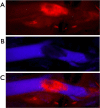Multifunctional agents for concurrent imaging and therapy in cardiovascular disease
- PMID: 20654664
- PMCID: PMC2974776
- DOI: 10.1016/j.addr.2010.07.004
Multifunctional agents for concurrent imaging and therapy in cardiovascular disease
Abstract
The development of agents for the simultaneous detection and treatment of disease has recently gained significant attention. These multifunctional theranostic agents posses a number of advantages over their monofunctional counterparts, as they potentially allow for the concomitant determination of agent localization, release, and efficacy. Whereas the development of these agents for use in cancers has received the majority of the attention, their use in cardiovascular disease is steadily increasing. As such, this review summarized some of the most poignant recent advances in the development of theranostic agents for the treatment of this class of diseases.
Copyright © 2010 Elsevier B.V. All rights reserved.
Figures





Similar articles
-
Theranostic nanoparticles for cancer and cardiovascular applications.Pharm Res. 2014 Jun;31(6):1390-406. doi: 10.1007/s11095-013-1277-z. Epub 2014 Mar 5. Pharm Res. 2014. PMID: 24595494 Review.
-
Responsive theranostic systems: integration of diagnostic imaging agents and responsive controlled release drug delivery carriers.Acc Chem Res. 2011 Oct 18;44(10):1061-70. doi: 10.1021/ar2001777. Epub 2011 Sep 20. Acc Chem Res. 2011. PMID: 21932809 Free PMC article. Review.
-
Development and applications of photo-triggered theranostic agents.Adv Drug Deliv Rev. 2010 Aug 30;62(11):1094-124. doi: 10.1016/j.addr.2010.09.002. Epub 2010 Sep 19. Adv Drug Deliv Rev. 2010. PMID: 20858520 Free PMC article. Review.
-
Imaging and drug delivery using theranostic nanoparticles.Adv Drug Deliv Rev. 2010 Aug 30;62(11):1052-1063. doi: 10.1016/j.addr.2010.08.004. Epub 2010 Aug 13. Adv Drug Deliv Rev. 2010. PMID: 20709124 Free PMC article. Review.
-
Theranostic nanogels: multifunctional agents for simultaneous therapeutic delivery and diagnostic imaging.Nanoscale. 2024 Jul 25;16(29):14033-14056. doi: 10.1039/d4nr01423e. Nanoscale. 2024. PMID: 38990143 Review.
Cited by
-
Surface functionalized nanomaterial systems for targeted therapy of endocrine related tumors: a review of recent advancements.Drug Deliv. 2024 Dec;31(1):2390022. doi: 10.1080/10717544.2024.2390022. Epub 2024 Aug 13. Drug Deliv. 2024. PMID: 39138394 Free PMC article. Review.
-
Phase-shift, stimuli-responsive drug carriers for targeted delivery.Ther Deliv. 2011 Sep;2(9):1165-87. doi: 10.4155/tde.11.81. Ther Deliv. 2011. PMID: 22059114 Free PMC article. Review.
-
A non-invasive nanoparticles for multimodal imaging of ischemic myocardium in rats.J Nanobiotechnology. 2021 Mar 22;19(1):82. doi: 10.1186/s12951-021-00822-7. J Nanobiotechnology. 2021. PMID: 33752679 Free PMC article.
-
Near-infrared fluorescent probes in cancer imaging and therapy: an emerging field.Int J Nanomedicine. 2014 Mar 5;9:1347-65. doi: 10.2147/IJN.S60206. eCollection 2014. Int J Nanomedicine. 2014. PMID: 24648733 Free PMC article. Review.
-
Surface-modified nanotherapeutics targeting atherosclerosis.Biomater Sci. 2022 Sep 27;10(19):5459-5471. doi: 10.1039/d2bm00660j. Biomater Sci. 2022. PMID: 35980230 Free PMC article. Review.
References
-
- Kung HC, Hoyert DL, Xu J, Murphy SL. Deaths: final data for 2005. Natl Vital Stat Rep. 2008;56:1–120. - PubMed
-
- Jaffer FA, Nahrendorf M, Sosnovik D, Kelly KA, Aikawa E, Weissleder R. Cellular imaging of inflammation in atherosclerosis using magnetofluorescent nanomaterials. Mol Imaging. 2006;5:85–92. - PubMed
-
- Pande AN, Kohler RH, Aikawa E, Weissleder R, Jaffer FA. Detection of macrophage activity in atherosclerosis in vivo using multichannel, high-resolution laser scanning fluorescence microscopy. J Biomed Opt. 2006;11:021009. - PubMed
-
- Hyafil F, Cornily JC, Feig JE, Gordon R, Vucic E, Amirbekian V, Fisher EA, Fuster V, Feldman LJ, Fayad ZA. Noninvasive detection of macrophages using a nanoparticulate contrast agent for computed tomography. Nat Med. 2007;13:636–641. - PubMed
Publication types
MeSH terms
Substances
Grants and funding
LinkOut - more resources
Full Text Sources
Medical
Research Materials

